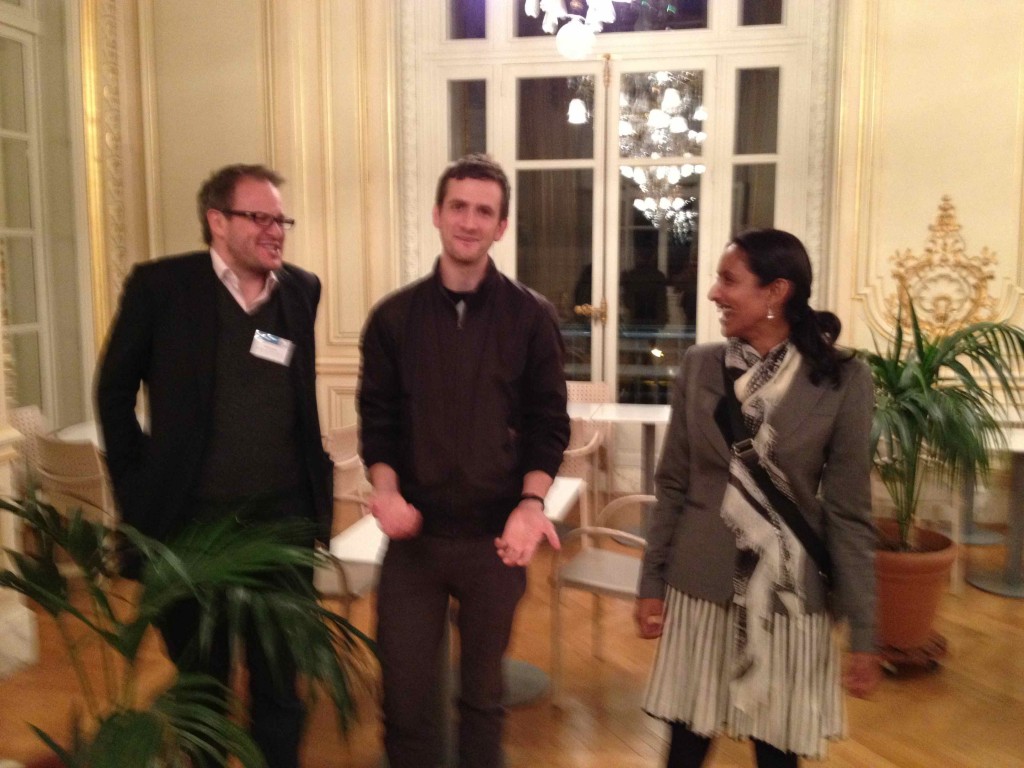
Stephen Feeney, with Jason McEwen and Hiranya Peiris at the Musee d’Orsay.
The fabulous Stephen Feeney submitted a brilliant thesis today. Bring on the viva!
We also welcome Dr Aurélien Benoit-Lévy to UCL. Aurélien will be working (among other things) on testing early universe physics using Planck and Dark Energy Survey data.
Stephen was very excited yesterday to see figures from his paper appearing on the BBC’s Horizon episode “How Big is the Universe?“. The BBC article associated with the episode (with a clip from the show) is here.
Our results on a search for textures in the cosmic microwave background have been featured in Science‘s Editor’s Choice. The BBC website also published an article about our work!
FQXi talked to Stephen Feeney and Hiranya Peiris about cosmic textures, and more generally about how we know what we know about the origin and evolution of the Universe, in their podcast. Our co-author Matt Johnson blogged about our search for textures, also at FQXi.
The 2012 Gruber cosmology prize has been awarded to Chuck Bennett and the Wilkinson Microwave Anisotropy Probe (WMAP) team. Hiranya is thrilled to share this honour with such an amazing group of people!
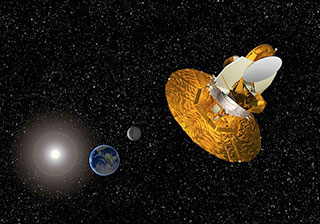
Credit: NASA/WMAP Science Team
The citation reads:
The Gruber Foundation proudly presents the 2012 Cosmology Prize to Charles Bennett and the Wilkinson Microwave Anisotropy Probe team for their exquisite measurements of anisotropies in the relic radiation from the Big Bang—the Cosmic Microwave Background. These measurements have helped to secure rigorous constraints on the origin, content, age, and geometry of the Universe, transforming our current paradigm of structure formation from appealing scenario into precise science.
Other Members of the WMAP team are:
Chris Barnes, Rachel Bean, Olivier Doré, Joanna Dunkley, Benjamin M. Gold, Michael Greason, Mark Halpern, Robert Hill, Gary F. Hinshaw, Norman Jarosik, Alan Kogut, Eiichiro Komatsu, David Larson, Michele Limon, Stephan S. Meyer, Michael R. Nolta, Nils Odegard, Lyman Page, Hiranya V. Peiris, Kendrick Smith, David N. Spergel, Greg S. Tucker, Licia Verde, Janet L. Weiland, Edward Wollack, and Edward L. (Ned) Wright.
See the Gruber Foundation website for further details.
Theories of the primordial Universe predict the existence of knots in the fabric of space – known as cosmic textures – which could be identified by looking at light from the cosmic microwave background (CMB), the relic radiation left over from the Big Bang.
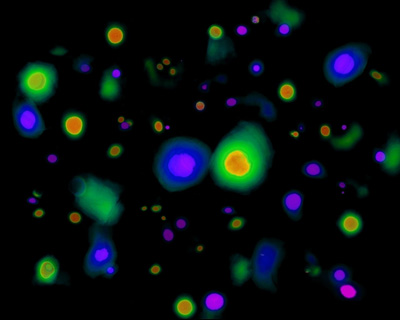
A random collection of textures taken from high-resolution, supercomputer simulations. Red indicates a positive twist in the topological charge density and blue a negative twist. Credit: V. Travieso and N. Turok
Using data from NASA’s Wilkinson Microwave Anisotropy Probe (WMAP) satellite, Stephen Feeney and Hiranya Peiris, with collaborators Matt Johnson (Perimeter Institute, Canada) and Daniel Mortlock (Imperial College London) have just performed the first search for textures on the full CMB sky, finding no evidence for such knots in space.
As the Universe cooled it underwent a series of phase transitions, analogous to water freezing into ice. Many transitions cannot occur consistently throughout space, giving rise in some theories to imperfections in the structure of the cooling material known as cosmic textures.
If produced in the early Universe, textures would interact with light from the CMB to leave a set of characteristic hot and cold spots. If detected, such signatures would yield invaluable insight into the types of phase transitions that occurred when the Universe was a fraction of a second old, with drastic implications for particle physics.
The new study, published in Physical Review Letters, places the best limits available on theories that produce textures, ruling out at 95% confidence theories that produce more than six detectable textures on our sky.
You can read the paper below!
Stephen M. Feeney, Matthew C. Johnson, Daniel J. Mortlock, Hiranya V. Peiris
Hiranya has been awarded the 2012 Royal Astronomical Society (RAS) Fowler Prize for Early Achievement in Astronomy, thus maintaining a fine UCL tradition (previous recipients from the UCL Astrophysics Group include Serena Viti, Sarah Bridle and Barbara Ercolano – Girl Power!).
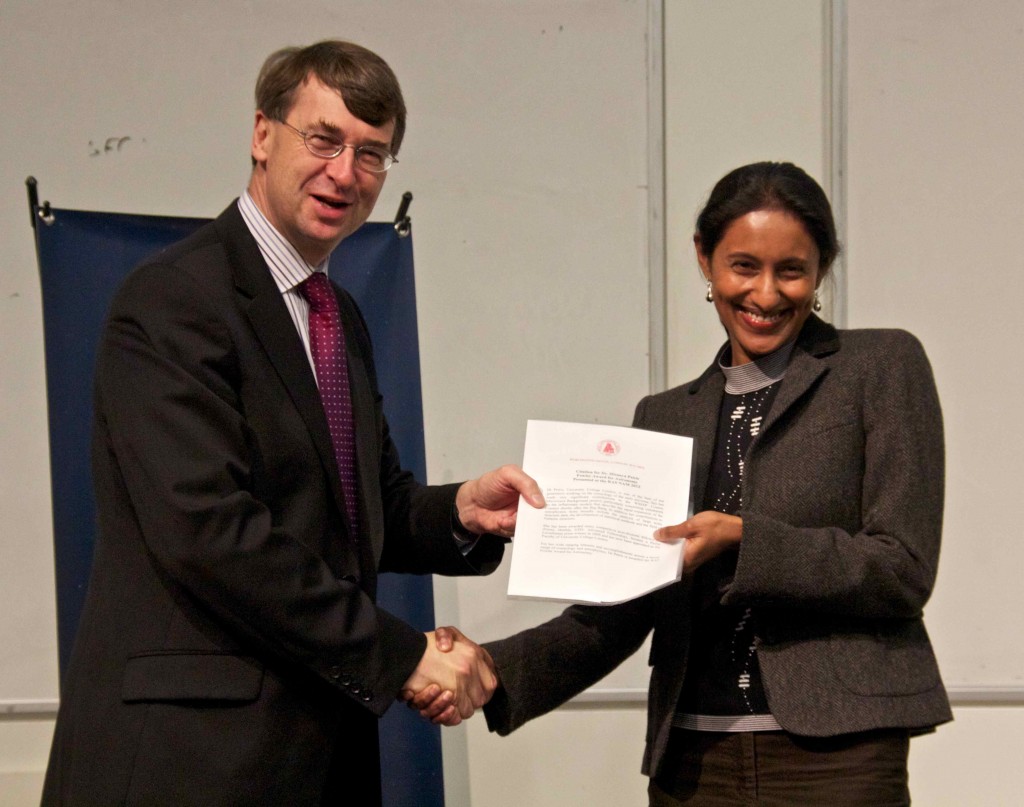
Credit: Mike Peel
The citation reads:
Dr Hiranya Peiris of University College London receives the Fowler Award in recognition of her particularly noteworthy contribution to astronomy at an early stage of her research career.
Dr Peiris is one of the best of her generation working on the cosmology of the early universe. She has made very significant contributions to the WMAP Cosmic Microwave Background project, particularly concerning constraints on the inflationary models that describe the rapid expansion of the cosmos shortly after the Big Bang. In addition her contributions to astrophysics more broadly include the analysis of large scale structure data, the development of statistical methods and the field of Galactic structure.
She has been awarded many competitive post-doctoral fellowships (Fermi, Hubble, STFC Advanced Fellowship), became a Philip Leverhulme prize-winner in 2009 and has now been appointed to the Faculty of University College London. With her wide ranging interests and accomplishments across a broad range of cosmology and astrophysics, Dr Peiris is awarded the RAS Fowler Award.
To read the full list of recipients and their citations, see the RAS website.
Our work on searching for cosmic bubble collisions in the CMB has been spotlighted in the Physical Review’s Physics. It has also been featured by the BBC (which unfortunately went with a sensational title not supported by our results), the National Geographic, the American Museum of Natural History, among others.
Hiranya Peiris talks to FQXi about the possibility of testing the multiverse here.
In October Matt Johnson and Hiranya spent a very enjoyable hour talking with Ed Gerstner of Big Science FM about
How did the Universe begin? What made it expand from the size of a grapefruit to billions of lightyears across in a fraction of a second after the Big Bang? And why did it stop? And is ours the only Universe?
You can listen to the podcast of our conversation here.
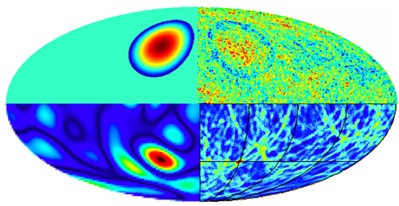
The signatures of a bubble collision at various stages in the analysis pipeline. A collision (top left) induces a temperature modulation in the CMB temperature map (top right). The ‘blob’ associated with the collision is identified by a large needlet response (bottom left), and the presence of an edge is highlighted by a large response from the edge detection algorithm (bottom right). In parallel with the edge-detection step, we perform a Bayesian parameter estimation and model selection analysis. Credit: Feeney et al. (2011)
Stephen Feeney and Hiranya Peiris, with collaborators Matt Johnson (Perimeter Institute, Canada) and Daniel Mortlock (Imperial College London) have put the theory that our universe is contained inside a bubble, and that multiple alternative universes exist inside their own bubbles – making up the ‘multiverse’ – to the test for the first time.
Many modern theories of fundamental physics predict that our universe is contained inside a bubble. In addition to our bubble, this ‘multiverse’ will contain others, each of which can be thought of as containing a universe. In the other ‘pocket universes’ the fundamental constants, and even the basic laws of nature, might be different.
Until now, there had been no way to efficiently search for signs of bubble universe collisions in the CMB radiation, as the disc-like patterns in the radiation could be located anywhere in the sky. Additionally, we needed to be able to test whether any patterns we detected were the result of collisions or just random patterns in the noisy data.
Our team ran simulations of what the sky would look like with and without cosmic collisions and developed a ground-breaking algorithm to determine which fit better with the wealth of CMB data from NASA’s Wilkinson Microwave Anisotropy Probe (WMAP). We used this algorithm to put the first observational upper limit on how many bubble collision signatures there could be in the CMB sky.
One of many dilemmas facing physicists is that humans are very good at cherry-picking patterns in the data that may just be coincidence. However, our algorithm is much harder to fool, imposing very strict rules on whether the data fits a pattern or whether the pattern is down to chance.
These first results are not conclusive enough either to rule out the multiverse or to definitively detect the imprint of a bubble collision. However, WMAP is not the last word: new data currently coming in from the European Space Agency’s Planck satellite should help solve the puzzle.
